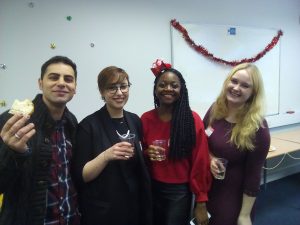Welcome to a new year and a new term – I hope you all had restful breaks with some fun in there somewhere too. Those who came along to the Birkbeck History of Art Society Christmas party on the last day of term began the holidays with a bang – huge thanks to the organisers and to Laura Jacobus for this photo:
This is also a time to welcome colleagues back from research leave – so a warm welcome back to Gabriel Koureas, and a fond (temporary) farewell to Laura Jacobus as she goes on leave for the Spring term. Very happy to be saying hello again to Peter Fane-Saunders, who taught in the department in 2016-17 and is rejoining us for the Spring term 2018.
A couple of events coming up to draw your attention to:
Carol Richardson will be giving the first of the term’s Murray Seminars in Medieval and Renaissance Art on the topic of Britons and Anglo-Saxons in Sixteenth-Century Rome: the 1580s fresco cycle at the English College. 17 January 5pm, Keynes Library – no need to book! Click here for the poster with the term’s seminars: Murray seminar Spring 2018
And our History and Theory of Photography Research Centre presents:
6 February 2018, 6:00-7:30pm, Keynes Library: The Touch of Light: Bruce Nauman’s Holograms – Elizabeth Johnson (Associate Research Fellow, Vasari Research Centre for Art and Technology)
Finally, a guest post from Sarah McBryde, a graduate of our Graduate Certificate and our MA History of Art currently doing a PhD under Dorigen Caldwell’s supervision. She recounts the thrilling/nerve-wracking experience of giving her first conference paper – and make sure to click through to her fascinating poster…
In December I was lucky enough to be selected to present my first academic paper titled ‘“A Gifted Dwarf” in the Court of Cosimo I de’Medici’, as part of a Graduate Student Session at the international conference, ‘Representing Infirmity: Diseased Bodies in Renaissance and Early Modern Italy’ at the Monash University Prato Centre in Italy. The conference organised by Jonathan K. Nelson, Fredrika Jacobs, Peter Howard and my PhD co-supervisor, John Henderson, was held in the grand ballroom of the 18th century Palazzo Vai, in the heart of Prato. Formerly a family home, then a gambling and social club for local businessmen, the palazzo became Monash’s Italian base in 2001 and still retains its ornate décor, sparkling with ‘coconut ice’ coloured glass and gilt chandeliers. As well as taking part in the conference I had also been invited to present my paper at the annual Monash Postgraduate Symposium the previous day. This gave me a chance to overcome a few nerves in the rather overwhelming setting, check my Powerpoint slides were actually going to work(!) and discuss a range of interesting research projects with a group of international MA and PhD students who were also participating.
The conference’s aim was to provide a platform for research into all aspects of Renaissance medicine and contemporary attitudes towards infirmities, diseases and disabilities. It brought together leading academics from the USA, Australia, Italy, Germany, Finland and the UK, and was opened by John Henderson whose keynote Bill Kent Memorial Lecture discussed religious and secular strategies to combat the 1630-33 plague outbreak in Florence. Other papers covered a broad array of subjects, from the depiction of goitres in Caravaggio’s Crucifixion of St Andrew (Danielle Carrabino), to external treatments such as cupping and scarification (Evelyn Welch), modes of portraying diseases without visible external symptoms (Sheila Barker) and the Franciscans’ treatment of leprosy in the 15th century (Diana Bullen Presciutti).
Preparing the paper itself was a useful learning curve, including how to write an abstract to fit a conference theme and design an academic poster. I also took part in a BISR Presentation Skills Training Day and was able to test my paper in the supportive environment of a ‘Writing the Object’ seminar with Lynda Nead, in front of my fellow History of Art research students (thank you all for your brilliant comments!). My experience in Prato was both memorable and rewarding. Although initially daunted by the thought of presenting my first paper, particularly at such an early stage in my project, the feedback and encouragement I received from other speakers, students and members of the audience was invaluable and has given me many ideas to follow up as I establish the parameters of my research.
WEBSITES:


